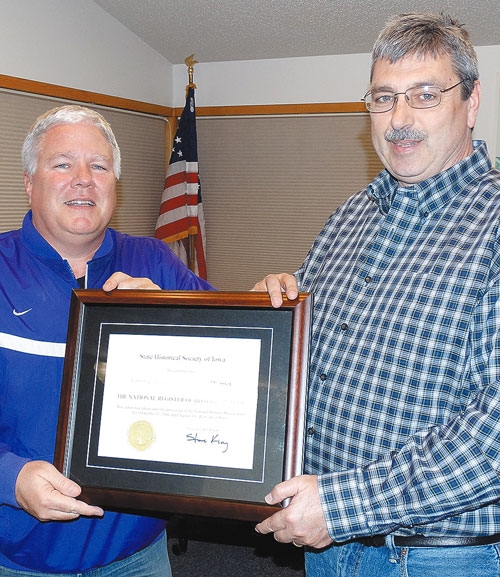You are here
Home ›Downtown Lansing designated as National Historic District, placed on National Register of Historic Places

Lansing's Mayor, Mike Brennan (left), and Dan Fisher (right), Executive Director of Main Street Lansing, hold the official announcement certificate for Lansing’s inclusion on the National Register of Historic Places, a division of the United States Park Service. Fisher received the proclamation this fall. A city-wide celebration will take place in May to showcase the historic district designation. The official area of the designation includes 100–401 Main Street, one block north and south on Front and 2nd streets, and 190 John Street. Submitted photo.
by Susan Cantine-Maxson
The downtown area of Lansing has been designated as a National Historic District and placed on the National Register of Historic Places, a division of the National Park Service. The National Park Service criteria for designation states, “The quality of significance in American history, architecture, archeology, engineering, and culture is present in districts, sites, buildings, structures, and objects that possess integrity of location, design, setting, materials, workmanship, feeling, and association.” The National Register of Historic Places is the official list of the nation's historic places worthy of preservation.
An official celebration for the designation will be held in Lansing in May, 2015, during National Historic Preservation month as established by the National Trust. The official area of the designation includes 100–401 Main Street, one block north and south on Front and 2nd streets, and 190 John Street.
Benefits
Being designated a historic district has several benefits. First, many tourists in the United States seek out places which are listed on the National Register. Research has shown that the history or heritage tourist tends to spend more money in their explorations than the average tourist. Increasing tourism is an important goal of Main Street Lansing because it will have a direct positive impact on the local economy. Second, one of the hallmark principles of the Main Street Iowa program is preservation of historically important architecture, particularly in downtown areas. Third, if individual property owners want to restore or rehabilitate their historic buildings and keep the historic look, they may be eligible for federal tax credits or local low interest loans from Kerndt Brothers Savings Bank. Individuals interested in more information about this process should contact Main Street Lansing at 563-538-9229. If property owners use their own money to make improvements, they may make whatever changes they want.
Main Street Lansing
The Main Street Lansing organization hopes that building owners will be want to maintain or restore their historic buildings in order to preserve the charm of the downtown. Maintaining a strong, visually appealing historic downtown will instill greater confidence in the future of the community. If the downtown is vital and flourishing, the rest of the town will benefit as well. MSL Board President Bruce Palmborg stated, “Preserving the past will protect the future of downtown Lansing.”
Nomination Process
This designation culminated a four year process of preparing for the submission of the nomination papers. A steering group began the process by applying for grants from the Iowa Historical Society. The National Park Service designates that each nomination be sponsored by a Certified Local Government. The Allamakee County Board of Supervisors serve as the Certified Local Government (CLG). The CLG is a partnership between local, state and national governments focused on promoting historic preservation at the local level. Iowa has the largest CLG program in the nation. The CLG program offers access to a numerous resources including expert advice from the National Park Service staff, networking with preservation professionals and access to federal funding. The Allamakee County Historic Preservation Commission was also instrumental in the nomination process. Both groups needed to approve the nomination before it was submitted.
After receiving approval from the CLG and the Allamakee Preservation Commission, Molly Myers Naumann, a consultant recommended by the state historical society, was hired to do the preliminary survey of the architectural and historical significance of the proposed district. Of the buildings in the proposed district, 42 were designated as contributing and nine were non-contributing (not historically relevant). The preponderance of historical buildings was a definite plus in proceeding with the nomination. Naumann and numerous volunteers researched the history of Lansing such as the development of businesses, the building materials and architecture, and interesting historical personalities. Local volunteer Gloria Payne from Harpers Ferry provided essential historical background from her research. Each phase of the research was funded by a variety of grants.
In 2013, all the paperwork was finished and the consultant proceeded with creating the final nomination, which was over 50 pages long. The nomination application and supporting materials are posted on the MSL website (http://www.mainstreetlansing.com/our-approach/reports). The application was submitted in June 2014. The state nomination review committee met and unanimously approved the application which was then sent to the National Park Service. The official date of Lansing’s designation was September 17, 2014.
Rehabilitation Tax Credits
According to the Iowa Department of Cultural Affairs, Iowa’s Historic Preservation and Cultural and Entertainment District Tax Credit program has been a significant factor in the rehabilitation of 284 buildings and the revitalization of 64 communities across Iowa. The Department of Cultural Affairs states, “This program has had a dramatic impact on the authentic character-defining properties of our State and our overall quality of life, while playing an important role in economic development.” All of these programs encourage the reuse of historic properties while retaining their historic charm. Ultimately, each of these programs contributes to the revitalization and preservation of historic properties across the state.

